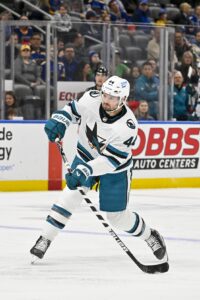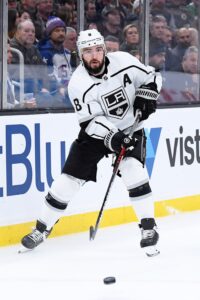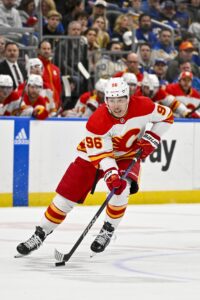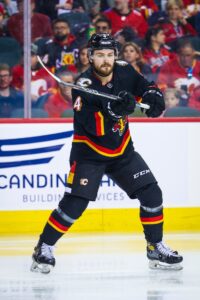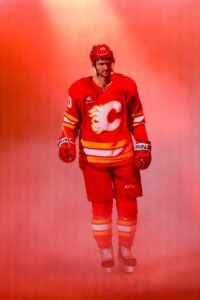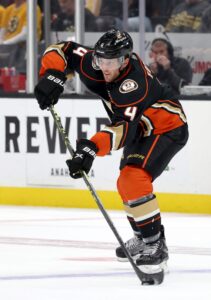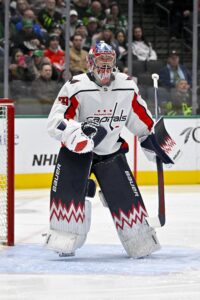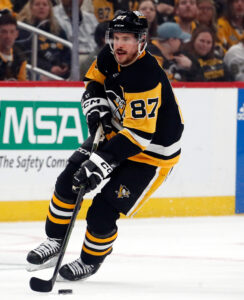Navigating the salary cap is one of the most important tasks for a front office. Teams that can avoid total cap chaos by walking the tightrope of inking players to deals that match their value (or compensate for future value without breaking the bank) remain successful. Those that don’t often see struggles and front office changes.
PHR will look at every NHL team and give a thorough look at their cap situation for the 2024-25 season. This will focus more on players who are regulars on the roster versus those who may find themselves shuttling between the AHL and NHL. All cap figures are courtesy of PuckPedia. We’re currently covering the Pacific Division, next up is the Kraken.
Seattle Kraken
Current Cap Hit: $90,108,465 (above the $88MM Upper Limit)
Entry-Level Contracts
D Ryker Evans (one year, $898K)
F Tye Kartye (one year, $859K)
F Shane Wright (three years, $887K)
Potential Bonuses
Kartye: $57.5K
Wright: $3.0625MM
Total: $3.12MM
Seattle was slow-playing Wright’s development in his first couple of seasons and even into his first full NHL campaign, his ice time is being managed carefully. Accordingly, he’s not on track to reach any of his bonuses and is probably heading for a bridge contract barring a big offensive breakout over the next year or two. If he stays on the slower development path, that bridge agreement should come in around the $3.5MM range. Kartye had a solid rookie season in the bottom six and is in that same role this year. His bonuses are based on games played so that’s something he should be able to reach if he stays healthy. Given his role and limited offensive numbers, he’s also looking at a short-term second contract, one around the $1.5MM mark.
Evans is in his first full NHL season after impressing in partial duty last season. He has locked down a spot in Seattle’s top four and is tied for the team lead in scoring among blueliners. If that holds up, it wouldn’t be surprising to see GM Ron Francis try to work out a long-term deal, one that would check in a bit below their top veterans who are making a little over $7MM per season. A bridge agreement, meanwhile, would likely fall in the $4MM range. Either way, a big raise is coming his way this summer.
Signed Through 2024-25, Non-Entry-Level
D William Borgen ($2.7MM, UFA)
F Yanni Gourde ($5.167MM, UFA)
D Josh Mahura ($775K, UFA)
F Daniel Sprong ($975K, UFA)
F Brandon Tanev ($3.5MM, UFA)
For most of his contract, Gourde has been well worth the contract, generally producing above a 40-point pace. But he struggled last season and is off to a similar start offensively this year which will hurt his value. Now that he’s being deployed as more of a third-line option, it would be difficult to see him command a similar price tag at 33. But a multi-year deal around $4MM per season should still be within reach.
Tanev’s contract felt like a steep overpayment at the time for someone who had only reached 20 points once at the time it was signed. However, he has produced enough offensively (when healthy) on this deal to at least reasonably justify the cost while providing plenty of physicality and enough defensive acumen to make it a fair deal overall. While most teams want to cut salary from their bottom six, he could be an outlier and land another contract around this price point. Sprong didn’t have much luck on the open market last summer despite his second straight year of over 40 points and things haven’t gone well for him this year. Accordingly, another dip might be coming his way.
Borgen had two straight seasons of at least 20 points coming into this one but his production and playing time have slipped through the first quarter of this year. Heading into the year, a jump to the $3.75MM range seemed possible, especially as a right-hand shot but that might come down more toward the $3.5MM level on a multi-year deal now. Mahura was only able get a minimum contract after being non-tendered by Florida and with the limited role he has had so far, he’s unlikely to command more than that next summer.
Signed Through 2025-26
F Oliver Bjorkstrand ($5.4MM, UFA)
F Jordan Eberle ($4.75MM, UFA)
D Jamie Oleksiak ($4.6MM, UFA)
F Jaden Schwartz ($5.5MM, UFA)
F Eeli Tolvanen ($3.475MM, UFA)
Schwartz was one of Seattle’s first free agent additions, a move that hasn’t panned out as well as they hoped. When healthy, he’s a capable second-line forward but staying healthy has been a serious challenge thus far. He’ll be 34 when his next contract starts and it’d be surprising if he came in at this price tag next time. Something in the $4MM range on a medium-term deal might be more likely. Bjorkstrand was acquired as a cap dump from the Blue Jackets in 2022 and he has given Seattle two straight 20-goal seasons plus a 59-point effort last year. If he can keep near 60 points, he could land another million or so on his next deal. But if he reverts to a point total more in the 40s, Bjorkstrand might have to settle for a bit less than his current salary in 2026.
Eberle signed this deal last season, taking himself off the trade block in the process. He’s still a capable secondary scorer but considering he’ll be 36 on his next deal (subject to 35-plus provisions on a multi-year contract), it wouldn’t be surprising if he went year-to-year from here on out, allowing for the possibility for a lower base salary with reachable performance bonuses to allow the signing team more flexibility. Tolvanen has turned into one of the better waiver claims in recent memory, picking up 41 points last season while being on pace for 20 goals this year. Still, he’s a bit inconsistent which has kept him out of a full-time top-six role. If that continues and he settles in as more of a middle-six option, his open market value will take a hit although he could still get a small increase if he stays in that 40-point range.
 There was definitely some risk in the contract the Kraken gave Oleksiak after selecting him in expansion. He had been a third-pairing player up to that point with the exception of one year, the one that landed him this agreement. But Oleksiak has been able to maintain a top-four slot throughout his time with Seattle while even chipping in with a career year offensively in 2022-23. Of course, his offensive numbers don’t land him this role or this type of money but rather his defensive game (and being one of the tallest players in the league). The market isn’t as strong for the more stay-at-home type of players and Oleksiak will turn 34 early in the 26-27 season but even so, a small boost to the $5MM range on a medium-term pact could still be doable.
There was definitely some risk in the contract the Kraken gave Oleksiak after selecting him in expansion. He had been a third-pairing player up to that point with the exception of one year, the one that landed him this agreement. But Oleksiak has been able to maintain a top-four slot throughout his time with Seattle while even chipping in with a career year offensively in 2022-23. Of course, his offensive numbers don’t land him this role or this type of money but rather his defensive game (and being one of the tallest players in the league). The market isn’t as strong for the more stay-at-home type of players and Oleksiak will turn 34 early in the 26-27 season but even so, a small boost to the $5MM range on a medium-term pact could still be doable.
Signed Through 2026-27
F Andre Burakovsky ($5.5MM, UFA)
G Philipp Grubauer ($5.9MM, UFA)
D Vince Dunn ($7.35MM, UFA)
F Jared McCann ($5MM, UFA)
Burakovsky was another notable splash in free agency that hasn’t worked out particularly well thus far. Signed off a career year, he hasn’t been able to produce close to those numbers since then, nor has he stayed healthy. Lots can still change in the back half of the deal but he looks like someone heading for a cap hit closer to the $4MM range, if not less next time out. McCann, on the other hand, averaged 30 goals and 62 points over his first three seasons in Seattle, two of which were played on this contract. That’s a solid return for this price point and if those numbers continue, he could land closer to $7MM next time out, especially with the ability to play center.
Dunn is the other player who could challenge McCann as being the best of their original expansion picks. With a bigger role than he had with St. Louis, he has emerged as one of the better offensive blueliners league-wide while playing in all situations. In essence, he has the numbers of arguably a number one defender, if not a top-pairing piece. He’ll be turning 31 early in the 2027-28 season so a max-term contract is a very realistic possibility and if Dunn remains as impactful as he has been, he could add a couple million per season on that next deal.
 Grubauer was a free agent acquisition that carried some risk given that he was coming off a breakout year with a career-high in games played of 40. Paying him to be the undisputed starter for that long had the potential to bust. And bust it has. After putting up a .922 SV% in his best year with Colorado, he has yet to reach the .900 mark since then. Along the way, Grubauer has gone from being their number one goalie to a part-time backup and is off to a dreadful start this season. Barring a change in fortunes, Seattle will need to seriously consider buying out the remainder of this deal this summer, even with it carrying close to a $2MM dead cap charge next season, nearly $3.1MM the following year, and close to $1.7MM for two years after that.
Grubauer was a free agent acquisition that carried some risk given that he was coming off a breakout year with a career-high in games played of 40. Paying him to be the undisputed starter for that long had the potential to bust. And bust it has. After putting up a .922 SV% in his best year with Colorado, he has yet to reach the .900 mark since then. Along the way, Grubauer has gone from being their number one goalie to a part-time backup and is off to a dreadful start this season. Barring a change in fortunes, Seattle will need to seriously consider buying out the remainder of this deal this summer, even with it carrying close to a $2MM dead cap charge next season, nearly $3.1MM the following year, and close to $1.7MM for two years after that.

